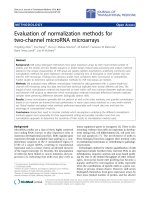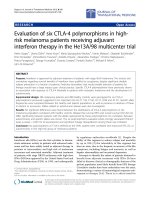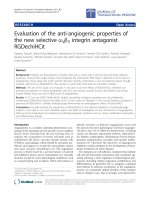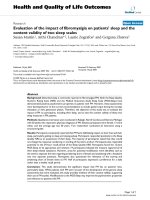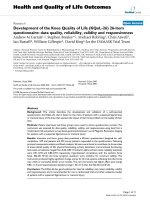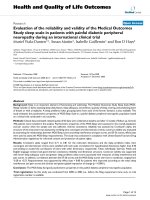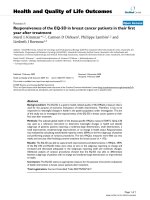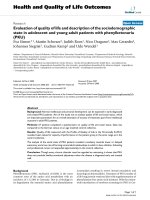Báo cáo hóa học: " Evaluation of quality of life and description of the sociodemographic state in adolescent and young adult patients with phenylketonuria (PKU)" docx
Bạn đang xem bản rút gọn của tài liệu. Xem và tải ngay bản đầy đủ của tài liệu tại đây (227.57 KB, 7 trang )
BioMed Central
Page 1 of 7
(page number not for citation purposes)
Health and Quality of Life Outcomes
Open Access
Research
Evaluation of quality of life and description of the sociodemographic
state in adolescent and young adult patients with phenylketonuria
(PKU)
Eva Simon*
1
, Martin Schwarz
3
, Judith Roos
1
, Nico Dragano
2
, Max Geraedts
2
,
Johannes Siegrist
2
, Gudrun Kamp
2
and Udo Wendel
1
Address:
1
Department of General Pediatrics, Heinrich Heine University, Duesseldorf, Germany,
2
Department of Medical Sociology, Heinrich
Heine University, Duesseldorf, Germany and
3
Department of Gastroenterology, Hepatology and Infectious Diseases, Heinrich Heine University,
Moorenstrasse, Duesseldorf, Germany
Email: Eva Simon* - ; Martin Schwarz - ; Judith Roos -
duesseldorf.de; Nico Dragano - ; Max Geraedts - ; Johannes Siegrist - siegrist@uni-
duesseldorf.de; Gudrun Kamp - ; Udo Wendel -
* Corresponding author
Abstract
Background: Normal intellectual and personal development can be expected in early-diagnosed
and treated PKU patients. Aim of the study was to analyse quality of life and social status, which
are important parameters for an overall estimation of success of treatment apart from intellectual
outcome in adult PKU patients.
Methods: 67 patients completed a questionnaire on quality of life and social status. Data was
compared to the German census on an age matched control collective.
Results: Quality of life measured with the Profile of Quality of Life in the Chronically Ill (PLC)
revealed mean values for capacity of performance in the patient group in the same range as in the
control collective.
The analysis of the social state of PKU patients revealed a tendency towards lower or delayed
autonomy, and a low rate of forming normal adult relationships in which to have children. Schooling
and professional career corresponded approximately to the control collective.
Conclusion: Though every chronic disorder must be regarded as restraining, it shows that PKU
does not preclude healthy emotional adjustment when the disease is diagnosed early and treated
well.
Background
Phenylketonuria (PKU, McKusick 261600) is the most
common error of the amino acid metabolism with an
incidence of 1:12.000 in Germany. Due to a blockage in
its degradation the essential amino acid phenylalanine
accumulates resulting in severe mental retardation and
neurological abnormalities. Treatment of PKU consists of
a life-long protein-restricted diet with supplementation of
phenylalanine-free amino acid mixtures. With the nation-
wide introduction of newborn screening for PKU in Ger-
Published: 26 March 2008
Health and Quality of Life Outcomes 2008, 6:25 doi:10.1186/1477-7525-6-25
Received: 30 June 2007
Accepted: 26 March 2008
This article is available from: />© 2008 Simon et al; licensee BioMed Central Ltd.
This is an Open Access article distributed under the terms of the Creative Commons Attribution License ( />),
which permits unrestricted use, distribution, and reproduction in any medium, provided the original work is properly cited.
Health and Quality of Life Outcomes 2008, 6:25 />Page 2 of 7
(page number not for citation purposes)
many in the 1970s and the early institution of the diet,
mental retardation due to PKU has been almost elimi-
nated. Raised phenalanine levels in pregnancy exert
adverse effects on the fetus (maternal PKU with micro-
cephaly, growth retardation, developmental delay and
congenital heart disease), therefore compliance with treat-
ment must be especially strict.
Substantial knowledge has been gained of the intellectual
[1], neurocognitive [2,3] and psychiatric state [4-7] of
patients with phenylketonuria (PKU, McKusick 261600).
This experience allows for a vast overview but further
parameters are necessary for an overall estimation of a
patient's outcome. Such important aspects of interest for
the outcome of PKU patients are quality of life and social
outcome.
Quality of life (QoL) is a multidimensional concept
reflecting the impact of disease and treatment on a
patient's subjective evaluation of his or her functioning
and emotional well-being. PKU is a relatively benign dis-
ease with a good subjective physical function and a low
number of hospitalisations. A completely normal per-
sonal development can be expected in early treated
patients [8]. All the same, frequent blood tests for moni-
toring, the necessity of compliance with a complex diet,
the occurrence of neurological symptoms and the stigma
of the diagnosis of an inborn error of metabolism are fea-
tures that make it reasonable to assume PKU may have
impact on the quality of life in affected individuals.
In addition to a poor subjective perception of quality of
life, suffering from a chronic inborn disease might impose
special problems resulting in an exceptional social struc-
ture (interpersonal relationships, education and profes-
sional career) in comparison to healthy peers.
After the introduction of newborn screening for PKU in
the 1960s, the number of early diagnosed and early
treated adult patients continues to increase. Normal out-
come is expected in these patients. High quality of life, a
normal social status and an independent adult lifestyle are
major goals of treatment.
Methods
104 early treated PKU patients aged 17 years and above,
who formerly or actually attended the metabolic units of
the University Hospitals in Duesseldorf or Cologne, were
invited by mail to participate in the study. A total of 67
patients completed and returned the standardized self-
assessed questionnaire (response rate 64%). Time of ques-
tionnaire dispatch was July 2003.
Quality of life was enquired with the Profile of Quality of
Life in the Chronically Ill (PLC) questionnaire [9]. The
PLC is an approved questionnaire with a satisfactory crite-
rion validity that has been used in a number of studies on
QoL in chronic diseases. Data on the German population
between 14 and 92 years have been collected for compar-
ison of patient groups with a normal collective. The core
module of this approved questionnaire is composed of 40
Likert-scaled items (scale 0–4) with 0 representing mini-
mum and 4 representing maximum satisfaction. The
items measure physical, psychological and social capacity
of performance and well-being (for details see table 1). In
addition to the core module, disease-specific symptoms
depending on the investigated patient collective can be
added to the questionnaire. Patients were asked if they
suffered from memory impairment, headache, tremor of
hands, tremor of arms and legs, lack of dexterity, slow
reaction and skin abnormalities which are rather frequent
symptoms in PKU [10-13] during the last seven days
before filling in the questionnaire.
The QoL patient data were compared to data on an
approximately age-matched control collective (aged
18–34 years) representative for the German population
[14]. The patient collective was then divided into two age
groups (≤25 years vs. >25 years) in order to detect possible
age-dependent differences in QoL. Furthermore QoL in
male and female patients was compared.
Table 1: Theoretical dimensions and factorial structure of the PLC (Siegrist et al 1996)
Capacity of Performance Well-being
Physical I. Physical functioning Listing of Symptoms
(Performance capacity)
8 items
Psychological II. Psychological Functioning III. Positive Mood (5 items)
(Capacity of enjoying and relaxing) IV. Negative Mood (8 items)
(8 Items)
Social V. Social Functioning VI. Social Well-being
(Capacity of performing in social roles) (Feelings of belonging)
(6 items) (5 items)
Health and Quality of Life Outcomes 2008, 6:25 />Page 3 of 7
(page number not for citation purposes)
Data were analysed with SPSS-12 (SPSS Inc, Chicago, IL).
The Wilcoxon Rank-Sum (Mann-Whitney-U), a non-para-
metric test (distribution-free) was used to compare differ-
ences. P < 0.05 was considered to indicate statistically
significant difference. In case of multiple testing (e.g.
quality of life subscales) p-values were rated using Bonfer-
roni correction.
In the second section of the questionnaire, information
about the patients' socioeconomic and sociodemographic
status (marital status, children, type of habitation, school
education, professional career, labour force) were col-
lected. Frequencies were run and data were compared to
data drawn from the German 2003 census on the age-
matched general population of the same German prov-
ince (North Rhine-Westphalia) where the patients lived
and were treated for their PKU. As no data on type of hab-
itation were available from the census of North Rhine-
Westphalia, the German population (age 18–34 years)
was taken as a control group for this parameter.
At the time of the survey the patients were aged between
17 and 38 years with a median age of 25 years. The
median age was higher in the male than in the female
patient collective (28,5 vs. 23 years). Supposing an even
age distribution, the median age in the general population
would be 27,5 years.
The gender distribution in the patient group was uneven
with 34% male and 66% female patients, therefore data
were analysed separately for the male and the female
patient groups.
No identifiers were present on the sent documents and the
analysis was completely anonymous. The institutional
review board of the Heinrich-Heine University fully
approved the protocol for this investigation.
Results
Quality of life
No significant differences were detected between the self-
assessed QoL in the patient group and the control collec-
tive. The mean values for capacity of performance and
well being amount to 2,7–3,2 in the patient group and to
2,5–3,0 in the control collective (table 2). The mean
number of disease-specific symptoms in the patient col-
lective was 1 ± 0,9. Frequent symptoms were headache
and poor memory.
Patients older than 25 years stated more PKU-specific
symptoms than younger patients (Table 3) but the differ-
ence did not reach statistical significance (1.2 vs. 0.8, p =
0.08).
In the separate analysis of QoL of male and female
patients (table 4) women stated lower levels of positive
mood (Score 2.5 vs. 3.0, p = 0.02) and lower levels of psy-
chological functioning (Score 2.7 vs. 3.0, p = 0.09).
Women indicated higher scores in the category "social
wellbeing" (Score 3.2 vs. 2.9, p = 0.09). However, differ-
ences were small and p-values are above the defined
threshold (p > 0.001; Bonferroni corrected)
Sociodemographic and socioeconomic data
The data on marital status, children and habitation are
shown in table 5. Data on school and professional educa-
tion are summarised in table 6.
A great percentage of patients still lived with their parents
(48% of the male and 46% of the female patients) in con-
trast to approximately one quarter of the general popula-
tion.
The analysis of marital state revealed a higher percentage
of patients being unmarried in comparison to the general
population. This applied for the complete patient group
as well as for the male and female group taken separately
(>80% vs. 50–60%). The main proportion of the unmar-
ried patients were not in a steady relationship, in the male
patients this ratio was as high as 95%. While nearly half of
the subjects in the general population had children, this
was the case in only approximately 9% of the female and
18% of the male adult patients.
Concerning school education no obvious differences were
detected between patients and the general population.
Table 2: Comparison of mean QoL measured with the Profile of Quality of Life in the Chronically Ill (PLC) in PKU patients with the
German norm; Mean and Standard Deviation
Patient collective 17–38 years Mean (SD) Normal collective 18–34 years Mean (SD) Significance
Physical functioning 2.9 (0.6) 2.8 (0.6) n.s.
Psychological Functioning 2.8 (0.7) 2.7 (0.6) n.s.
Positive Mood 2.7 (0.8) 2.5 (0.7) n.s.
Negative Mood 3.2 (0.6) 3.0 (0.8) n.s.
Social Functioning 2.9 (0.9) 2.7 (0.7) n.s.
Social Well-being 3.1 (0.7) 3.0 (0.7) n.s.
Number of symptoms 1.0 (0.9) -
Health and Quality of Life Outcomes 2008, 6:25 />Page 4 of 7
(page number not for citation purposes)
The distribution of the highest professional qualifications
was the same, the only remarkable feature was that more
than half of the female patients had not finished a voca-
tional training at the time of the inquiry in contrast to
approximately one third in the general population.
The labour force status (table 6) in the patient collective
resembled the status in the general population. Differ-
ences were a higher percentage of part-time employees in
the male patient group than in the male general popula-
tion, while the proportion of part time employees was
slightly lower in the female patient group than in the nor-
mal population.
Discussion
Quality of life
QoL is a multidimensional measure that is increasingly
being used to evaluate outcome apart from clearly verifia-
ble clinical symptoms. Physical, emotional, and social fac-
tors of subjective well being are summarised in this
measure. QoL is suitable for the evaluation of affection by
illness and treatment, and therefore might help illuminate
areas of concern to a patient that have been previously
under-recognised.
Till date, few studies investigated QoL as an outcome
measure in PKU patients. In different studies on psycho-
pathology in PKU in the 1990s, adolescent PKU patients
stated reduced self-autonomy and a restricted social situa-
tion [15-19]. The necessity of compliance with a diet cre-
ated a feeling of being poorly integrable in their peer
groups [20]. In 37 Swiss patients between 3 and 18 years
a normal QoL was stated in a standardised questionnaire
filled in by the parents of the affected children. The only
statistically significant abnormality in comparison to a
healthy control collective was the presence of less positive
emotions in the patient group [21]. In a recent study with
32 young adult Dutch patients self-assessed health-related
quality of life was comparable to quality of life of controls
[22].
In the present study QoL was measured with the Profile of
Quality of Life in the Chronically Ill (PLC). In this ques-
tionnaire the two aspects of QoL, performance capacity
and well being, are weighted equally resulting in an eval-
uation of negative feelings as well as constrictions in eve-
ryday life. The questionnaire has been used in different
groups of chronically ill [9] and has been proven to have
a satisfactory discriminant and criterion validity.
No significant differences were detected between the self-
assessed QoL in adolescent and adult PKU patients and
the control collective. Adults above 25 years stated more
PKU specific neurological symptoms than younger
patients but this difference did not reach statistical signif-
icance. Apart from a deterioration of neurological symp-
toms with advancing age as described in adult patients
after the discontinuation of a diet [23,24], a possible
cause might be a more intense reflection on the disease
with advancing age resulting in the perception of more
intense symptoms.
Table 3: Comparison of mean QoL in patients under and above 25 years; Mean and Standard Deviation
Patient collective 17–25 years Mean (SD) Patient collective 25–37 years Mean (SD) Significance
Physical functioning 3.0 (0.8) 3.0 (0.4) n.s.
Psychological Functioning 2.8 (0.8) 2.8 (0.5) n.s.
Positive Mood 2.6 (0.9) 2.8 (0.6) n.s.
Negative Mood 3.1 (0.6) 3.3 (0.4) n.s.
Social Functioning 3.0 (0.7) 2.8 (0.7) n.s.
Social Well-being 3.0 (0.8) 3.1 (0.7) n.s.
Number of symptoms 0.8 (0.9) 1.2 (1.0) n.s.
Table 4: Comparison of mean QoL in male and female patients; Mean and Standard Deviation
Patient collective Female Mean (SD) Patient collective Male Mean (SD) Significance
Physical functioning 2.9 (0.7) 3.0 (0.5) n.s.
Psychological Functioning 2.7 (0.7) 3.0 (0.6) (p = 0.09)
Positive Mood 2.5 (0.8) 3.0 (0.6) (p = 0.02)
Negative Mood 3.1 (0.6) 3.3 (0.5) n.s.
Social Functioning 2.9 (0.7) 2.9 (0.7) n.s.
Social Well-being 3.2 (0.7) 2.9 (0.7) (p = 0.09)
Range of scales: 0–4; low values = low quality of life, high value = high quality of life, SD, standard deviation; n.s., not significant
Health and Quality of Life Outcomes 2008, 6:25 />Page 5 of 7
(page number not for citation purposes)
More intense reflection might also be the cause for a ten-
dency towards reduced capacity of enjoying and relaxing
and a less positive mood in the female patients. Addition-
ally, to deal with the problem of maternal PKU might also
result in a less positive mood in the female patient group.
The subjective appraisal of QoL might have been very pos-
itive because adult PKU patients possibly inadvertently
choose the form of dealing with the disease resulting in
the best subjective quality of life: Compliant patients are
accustomed to the diet, so that they do not experience it as
a restriction; in non-compliant patients the burden of the
diet is inexistent and QoL is unimpaired as the subjects
experience no acute clinical symptoms of PKU or are used
to the mild symptoms.
Despite a normal estimation of QoL in the PLC, it is unde-
niable that PKU places a burden on a high number of
patients. Compliance with the diet, frequent visits at the
hospital and not least the sheer knowledge of the diagno-
sis of PKU are obvious stressors. Every chronic disorder
must be regarded as restraining, however, it shows that
PKU does not preclude healthy emotional and social
adjustment when the disease is diagnosed early and
treated well.
Sociodemographic and socioeconomic data
Social outcome is an important measure for the success of
treatment of an inborn chronic disease. In the present
analysis a number of differences became manifest in the
comparison between social outcome in a large collective
of young adult classic PKU patients and an age-matched
control collective.
In the patient group the marriage rate was low and only a
very small number of unmarried patients were in steady
relationships. Only 9% of the female and 18% of the male
patients had children. A low number of stable relation-
ships within to have children has been described fre-
quently in patients with chronic diseases [24-27] and was
attributed to poor body- or self-image. In contrast, a nor-
mal autonomy development, psychosocial development
and social development was found in 32 adult Dutch PKU
patients [22].
The analysis of type of habitation revealed an exception-
ally high percentage of patients still living with their par-
ents. This might be due to low autonomy in adolescent
and young adult PKU patients in comparison to healthy
members of the same age group. Suffering from a chronic
metabolic disease with the necessity of parental control of
behaviour and diet often results in overprotection in
childhood with a delay in achieving autonomy [27].
A normal intellectual outcome can be expected in early-
treated PKU patients. However, school performance as
well as professional career does not only depend on intel-
ligence. Recidiving elevations of phenylalanine concentra-
tions creating transient neuropsychological deficits
(impaired attention and short term memory) [2,3] as well
as behavioural and emotional factors experienced by chil-
dren and adolescents with a chronic disease may also play
a role for academic achievement. Previous studies evaluat-
ing school careers in patients with PKU came to different
results: German, Swiss and French studies did not detect
differences in school career comparing affected subjects to
the general population. In contrast, such differences were
present in a considerable part of American, British, Polish,
Table 5: Sociodemographic data: Marital state, children, habitation
Both sexes Male Female
Patient collective Normal collective Patient collective Normal collective Patient collective Normal collective
Marital state
Unmarried 82% 55% 83% 61% 82% 49%
Steady relationship 33% n.a. 22% n.a. 39% n.a.
No steady relationship 67% n.a. 78% n.a. 61% n.a.
Married 15% 42% 13% 37% 16% 47%
Divorced 3% 3% 4% 3% 2% 4%
Children 12% 47% 18% 33% 9% 51%
Type of habitation
Single household 18% 23,1% 30% 27% 11% 20%
Parents 46% 24,6% 48% 26% 46% 24%
Non-relative (shared flat) 3% n.a. 4% n.a. 2% n.a.
Marital or a illegitimate
partner
31% n.a. 17% n.a. 39% n.a.
Others 2% n.a. 0% n.a. 2% n.a.
n.a., data not available from the German census
Health and Quality of Life Outcomes 2008, 6:25 />Page 6 of 7
(page number not for citation purposes)
Hungarian, Austrian, Czech and Spanish PKU patients
[28-30]. A recent Dutch study revealed that a high percent-
age of PKU patients needed special education in primary
school, yet the final educational performance of the
patients was normal [22]. In our study collective the dis-
tribution of the highest school leaving certificates in the
patient group differed discretely from the frequencies in
the normal collective without a clear trend towards lower
education in the patients. Concerning professional career,
the high rate of female patients who had no professional
qualification might be due to their younger age in com-
parison to the control collective, but might as well be a
sign of delayed psychosocial development with unusually
long dependency on the parents without seeking eco-
nomic and social independence.
The observed higher percentage of part-time employment
in male patients might be a reflection of a lower achieve-
ment potential in chronically ill patients [26].
Taken together there is a tendency towards lower or
delayed autonomy possibly due to overprotection and a
low rate of forming normal adult relationships in PKU
patients.
Conclusion
The analysis of the social state of PKU patients revealed a
tendency towards lower or delayed autonomy, and a low
rate of forming normal adult relationships in which to
have children. Schooling and professional career corre-
sponded approximately to the control collective. Quality
of life measured with the Profile of Quality of Life in the
Chronically Ill (PLC) revealed mean values for capacity of
performance in the patient group in the same range as in
the control collective. Though every chronic disorder must
be regarded as restraining, it shows that PKU does not pre-
clude healthy emotional adjustment when the disease is
diagnosed early and treated well.
Table 6: School education and professional training
Both sexes Male Female
Patient collective Normal collective Patient collective Normal collective Patient collective Normal collective
Highest school leaving
certificate
Secondary school leaving
certificate
22% 26% 35% 30% 16% 23%
Intermediate school
leaving certificate
29% 26% 13% 23% 36% 29%
Entrance qualification for
university
33% 33% 39% 33% 30% 34%
Others/no information 16% 14% 13% 14% 18% 14%
Persons still in professional
training
43% 24% 35% 25% 48% 23%
Of these:
School of general
education
35% 26% 25% 24% 38% 28%
Apprenticeship 35% 49% 25% 50% 38% 47%
University student 29% 24% 50% 24% 19% 24%
Others/no information 3% 1% - - 5% -
Highest professional
qualification
No professional training
finished
48% 36% 25% 35% 55% 37%
Apprenticeship 43% 44% 52% 43% 39% 45%
Master craftsman/
technician
2% 5% - 6% 2% 4%
University degree 8% 9% 13% 10% 5% 9%
Others/no information - 5% - 6% - 5%
Labour force 73% 75% 74% 84% 73% 66%
Of these:
Unemployed 8% 11% 6% 12% 9% 9%
Part-time employed 22% 18% 24% 6% 22% 32%
Full-time employed 69% 72% 71% 82% 69% 59%
Health and Quality of Life Outcomes 2008, 6:25 />Page 7 of 7
(page number not for citation purposes)
Limitations of the present study should be acknowledged:
Although the recruitment rate was high, the sample size
was still small. It has to be assumed, that track of a consid-
erable percentage of patients was lost in late childhood
and adolescence. Thus, it is unclear to what extent our
results can be transferred to the overall PKU population.
Selection bias with the inclusion of only compliant,
socially adjusted patients has to be considered.
Furthermore, the small size of the sample limits the power
to detect subtle effects. Areas of concern to the patient
might have been under-recognised with the use of stand-
ardised questionnaires with formalised questions on cate-
gories chosen by the investigators.
Abbreviations
PKU: Phenylketonuria; QoL: Quality of life; PLC: Profile
of Quality of Life in the Chronically Ill.
Competing interests
The author(s) declare that they have no competing inter-
ests.
Authors' contributions
ES did the data analysis and drafted the manuscript. MS
and UW conceived of the study and designed the ques-
tionnaires. Both conducted the realisation and the analy-
sis of the study and helped to draft the manuscript. JR
participated in the design of the study and participated in
the analysis of the questionnaires. JR did the data collec-
tion. ND, MG and JS participated in the design and the
data analysis. ND did the statistical analysis. GK partici-
pated in the design of the questionnaires and helped to
draft the manuscript. All authors read and approved the
final manuscript.
Acknowledgements
The authors thank all patients who agreed to participate in the survey.
References
1. Burgard P: Development of intelligence in early treated phe-
nylketonuria. Eur J Pediatr 2000, 159:74-79.
2. Griffiths P: Neuropsychological approaches to treatment pol-
icy in phenylketonuria. Eur J Pediatr 2000, 159:82-86.
3. Huijbregts SCJ, de Sonneville LMJ, van Spronsen FJ, Licht R, Sergenat
JA: The neuropsychological profile of early and continuously
treated phenylketonuria: orienting, vigilance and maintain-
ance versus manipulation-functions of working memory.
Neurosci Biobehav Rev 2002, 26:697-712.
4. Griffiths P, Tarrini M, Robinson P: Executive function and neu-
ropsychological adjustment in children with early treated
phenylketonuria: correlation with historical and concurrent
phenylalanine levels. J Intellect Diabil Res 1997, 41:317-323.
5. Ris M, Weber A, Hunt M, Berry H, Williams S, Leslie N: Adult psy-
chosocial outcome in early-treated phenylketonuria. J Inherit
Metab Dis 1997, 20:499-508.
6. Sullivan J: Emotional outcome of adolescents and young adults
with early and continuously treated phenylketonuria. J Pediatr
Psychol 2001, 26:477-484.
7. Weglage J, Grenzebach M, Pietsch M, Feldmann R, Linnenbank R,
Dennecke J, Koch H: Behavioral and emotional problems in
early-treated adolescents with phenylketonuria in compari-
son with diabetic patients and healthy controls. J Inherit Metab
Dis 2000, 23:487-496.
8. Cleary M, Walter J: Assessment of adult phenylketonuria. Acta
Clin Biochim 2001, 38:450-458.
9. Siegrist J, Broer M, Junge A: Profil der Lebensqualität chronisch Kranker
(PLC) Göttingen, Hogrefe Verlag; 1986.
10. Koch R, Burtom B, Hoganson G, Peterson R, Rhead W, Rouse B,
Scott R, Wolff J, Stern AM, Guttler F, Nelson M, de la Cruz F, Cold-
well J, Erbe R, Geraghty MT, Shear C, Thomas J, Azen C: Phenylke-
tonuria in adulthood: A collaborative study. J Inherit Metab Dis
2002, 25:333-346.
11. McDonnell G, Esmonde T, Hadden D, Morrow J: A neurological
evaluation of adult phenylketonuria in Northern Ireland. Eur
J Neurol 1998,
39:38-43.
12. Pietz J, Dunckelmann R, Rupp A, Rating D, Meineck HM, Schmidt H,
Bremer H: Neurological outcome in adult patients with early
treated phenylketonuria. Eur J Pediatr 1998, 157:824-830.
13. Weglage J, Pietsch M, Fünders B, Koch H, Ullrich K: Neurological
findings in early treated phenylketonuria. Acta Paediatr 1995,
84:411-415.
14. Laubach W, Schröder C, Siegrist J, Brähler E: Normierung der Ska-
len „Profil der Lebensqualität Chronisch Kranker“ an einer
repräsentativen Stichprobe. Zeitschrift für differentielle und diag-
nostische Psychologie 2001, 22:100-110.
15. Burgard P, Armruster M, Schmidt E, Rupp A: Psychopathology of
patients treated early for phenylketonuria: results of the
German collaborative study of phenylketonuria. Acta Paeditr
Suppl 1994, 407:108-110.
16. Eiser C: Psychopathological effects of chronical disease. J Child
Psychol Psychiatry 1990, 38:85-98.
17. Esser G, Schmidt M, Wörner W: Epedimiology and the course of
psychiatric disorders in school-age children – results of a lon-
gitudinal study. J Child Psychol Psychiatry 1990, 31:243-263.
18. Waisbren S, Zaff J: Personality disorder in young women with
treated phenylketonuria. J Inherit Metab Dis 1995, 17:584-592.
19. Weglage J, Fünders B, Wilken B, Schubert S, Schmidt E, Burgard P, Ull-
rich K: Psychosocial and social findings in adolescents with
phenylketonuria. Eur J Pediatr 1992, 151:522-525.
20. Weglage J, Fünders B, Wilken B, Schubert D, Ullrich K: School per-
formance and intellectual outcome in adolescents with phe-
nylketonuria. Acta Paediatr 1993, 82:582-586.
21. Landolt M, Nuoffer J, Steinmann B, Superti-Fuga A: Quality of life
and psychosocial adjustment in children and adolescents
with early treated phenylketonuria can be normal. J Pediatr
2002, 40:516-521.
22. Bosch AM, Tybout W, van Spronsen FJ, de Valk HW, Wijburg FA,
Grootenhuis MA: The course of life and quality of life in early
and continuously treated Dutch patients with phenylketonu-
ria. J Inherit Metab Dis 2007, 30:29-34.
23. Brenton D, Pietz J: Adult care in phenylketonuria and hyper-
phenylalaninaemia: the relevance of neurological abnormal-
ities. Eur J Pediatr 2000, 159(Suppl 2):114-20.
24. Koch R, Yusin M, Fishler K: Successful adjustment to society by
adults with phenylketonuria. J Inherit Metab Dis 1985, 8:209-211.
25. Bhat M, Haase C, Lee P: Social outcome in treated individuals
with inherited metabolic disorders: UK study. J Inherit Metab
Dis 2005, 28:825-830.
26. Enns G, Packman W: The Adolescent with an inborn error of
metabolism: medical issues and transition to adulthood. Ado-
lesc med 2002, 13:315-329.
27. Lee P: Growing older: The adult metabolic clinic. J Inherit
Metab Dis 2002, 25:252-260.
28. Burgard P: Recent results on intelligence, school education
and information processing in patients early treated for phe-
nylketonuria. Pediatr Polska 1997, 6:25-32.
29. Gassio R, Fuste E, Lopez-Sala A, Artuch R, Vialesca M, Campistol J:
School performance in early and continuously treated phe-
nylketonuria. Pediatr Neurol 2005, 33:267-271.
30. Tiefenthaler M: Comments on patterns of academic achieve-
ment among early treated patients with phenylketonuria.
Eur J Pediatr 2000, 159(Suppl 2):100-1.


